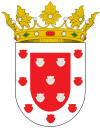Santiago de los Caballeros
| Santiago | ||
|---|---|---|
| City | ||
| Santiago de los Caballeros | ||
|
| ||
| ||
| Motto: In Spanish, La ciudad corazón | ||
 Santiago Location in the Dominican Republic | ||
| Coordinates: 19°28′N 70°42′W / 19.467°N 70.700°WCoordinates: 19°28′N 70°42′W / 19.467°N 70.700°W | ||
| Country |
| |
| Province | Santiago | |
| Municipality | Santiago de los Caballeros | |
| Founded | 1495 | |
| Government | ||
| • Governor | Aura Toribio | |
| • Mayor | Gilberto Serulle | |
| • Senator | Julio Cesar Valentin | |
| Area | ||
| • Total | 524.01 km2 (202.32 sq mi) | |
| Elevation[1] | 175 m (574 ft) | |
| Population (December 2010 −IX Census)[2] | ||
| • Total | 691,262 | |
| • Density | 1,300/km2 (3,400/sq mi) | |
| • Urban | 550,753 | |
| • Demonym | Spanish: masculine: Santiaguero / feminine: Santiaguera | |
| Municipal districts | 5 | |
| Website | Ayuntamiento de Santiago | |
Santiago de los Caballeros or simply Santiago (English: Saint James of the Knights) is a city in the Dominican Republic. Founded in 1495 during the first wave of European colonization of the New World, today Santiago (the first "Santiago" of the Americas) is the second largest metropolis in the Dominican Republic, located in the north-central region of the Republic known as Cibao valley.[3] This city is the capital of Santiago Province.
History
The original colony was in the city of Jacagua, which was founded in 1495, but when it was destroyed by an earthquake, it was moved to its present location in 1506. It was devastated by another earthquake in 1562. In 1805, Haitian general Henri Christophe invaded Santo Domingo and massacred several hundred residents of Santiago. Santiago de los Caballeros has at times been the capital of the country, and was an important strategic city in the Dominican War of Independence in 1844.
The name of the city, Saint James of the Knights, makes allusion to the Hidalgos de la Isabela, a group of knights who had come from La Isabela city to stay in Santiago. That they were actual knights is clear from the fact that when they got back to Spain they put a formal complaint before the king stating that their horses had been unfairly commissioned as beasts of burden and their weapons had been appropriated by the Columbus brothers (Diego and Bartolome) and that they had been made to do manual labor, something considered beneath their station as knights, who were meant to engage only in battle. The king compensated them for all their losses. Sometimes the city is even called Santiago de los 30 Caballeros (English: Saint James of the 30 Knights).
Geography
Santiago de los Caballeros is located on a hilly terrain in the middle of the Cibao Valley in the Central Region of the Dominican Republic, one of the most fertile lands found in the island. The Yaque del Norte River passes by Santiago which is in between the Cordillera Central and the Cordillera Septentrional, two of the three major mountain ranges on the island of Hispaniola, forming the Cibao Valley.
Climate
Santiago features a tropical wet and dry climate under the Köppen climate classification. The average temperature varies little in the city, because the tropical trade winds help mitigate the heat and humidity throughout the year. December and January are the coolest months and July and August are the warmest. Santiago and the rest of the country are in the Caribbean and have a tropical climate, which, when coupled with the city's altitude, 183 meters above sea level, causes cloudy conditions to persist through much of the year. Whilst the city lies within the Hurricane belt, Santiago is more sheltered than other parts of the country from hurricanes because of its location in the Cibao Valley.
| Month | Jan | Feb | Mar | Apr | May | Jun | Jul | Aug | Sep | Oct | Nov | Dec | Year |
|---|---|---|---|---|---|---|---|---|---|---|---|---|---|
| Record high °C (°F) | 34.4 (93.9) |
34.4 (93.9) |
37.2 (99) |
38.4 (101.1) |
36.2 (97.2) |
37.4 (99.3) |
36.2 (97.2) |
39.0 (102.2) |
41.0 (105.8) |
37.0 (98.6) |
36.8 (98.2) |
34.7 (94.5) |
41.0 (105.8) |
| Average high °C (°F) | 28.8 (83.8) |
29.4 (84.9) |
30.4 (86.7) |
31.2 (88.2) |
31.8 (89.2) |
32.9 (91.2) |
33.0 (91.4) |
33.2 (91.8) |
33.3 (91.9) |
32.4 (90.3) |
30.3 (86.5) |
28.7 (83.7) |
31.3 (88.3) |
| Daily mean °C (°F) | 23.5 (74.3) |
23.8 (74.8) |
24.7 (76.5) |
25.5 (77.9) |
26.5 (79.7) |
27.4 (81.3) |
27.5 (81.5) |
27.7 (81.9) |
27.6 (81.7) |
26.9 (80.4) |
25.2 (77.4) |
23.7 (74.7) |
25.8 (78.4) |
| Average low °C (°F) | 18.2 (64.8) |
18.4 (65.1) |
19.0 (66.2) |
19.9 (67.8) |
21.2 (70.2) |
22.1 (71.8) |
22.2 (72) |
22.2 (72) |
21.9 (71.4) |
21.5 (70.7) |
20.2 (68.4) |
18.7 (65.7) |
20.5 (68.9) |
| Record low °C (°F) | 11.2 (52.2) |
12.2 (54) |
12.0 (53.6) |
12.7 (54.9) |
16.3 (61.3) |
18.5 (65.3) |
17.0 (62.6) |
17.6 (63.7) |
18.6 (65.5) |
17.5 (63.5) |
15.0 (59) |
12.0 (53.6) |
11.2 (52.2) |
| Average rainfall mm (inches) | 49.8 (1.961) |
47.7 (1.878) |
59.2 (2.331) |
104.4 (4.11) |
151.2 (5.953) |
67.6 (2.661) |
56.4 (2.22) |
73.1 (2.878) |
96.8 (3.811) |
109.7 (4.319) |
125.6 (4.945) |
80.2 (3.157) |
1,021.7 (40.224) |
| Avg. rainy days (≥ 1.0 mm) | 7.4 | 6.2 | 5.7 | 7.9 | 10.5 | 5.6 | 7.2 | 8.0 | 8.1 | 8.7 | 10.7 | 9.8 | 95.8 |
| Average relative humidity (%) | 77.8 | 75.9 | 72.6 | 72.5 | 74.8 | 72.4 | 71.9 | 72.6 | 74.0 | 76.1 | 79.1 | 79.6 | 74.9 |
| Source #1: NOAA[4] | |||||||||||||
| Source #2: Temperature Extreme Records [5][6][7] | |||||||||||||
Economy

The city of Santiago, as most of the Cibao region, is largely dependent on the fertile lands of the region. This makes Santiago de los Caballeros an important region for farming and livestock. The city has been recently changing into a predominantly service provider economy. This sector has grown a lot in the recent years making it ideal for greater expansion. It should be noted that Santiago is the 2nd largest city in the Dominican Republic after Santo Domingo and concurrently produces the 2nd highest percentage of the nations GDP. Telecommunications, such as; wireless phones, cable service, internet service and other services are important for the local economy. Tourism too, accounts for an important portion of the city's economy.
Growth and development
Like Santo Domingo, Santiago has recently experienced an era of rapid growth and development. It has become a city of great importance for the nation and the region's development. Santiago like any other fast growing city is faced with numerous problems including irregular electricity service and insufficient potable water. The approximate population of Santiago is about 691,262 inhabitants (as of 2010).[8]
Arts and culture
Architecture
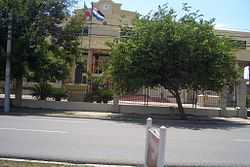
The Cathedral of Santiago was built in 1895 by Onofre de Lora, an architect native to the city.[9]
The Hermanos Patiño Bridge is both the largest and oldest bridge in the city connecting the North and South sides of the city of Santiago. Its construction was started by Rafael Leónidas Trujillo and inaugurated in 1962, one year after his death. The bridge is named after the five brothers that died in an effort to end Trujillo's regime and dictatorship in the Dominican Republic in the mid 20th century. The anti-Trujillo legacy of the Patiño family did not begin with the brothers, but with their father who was killed in 1931 in the first anti-Trujillo insurrection of the Dominican Republic.[10]
On a hill overlooking Santiago is a 67 meters (220 ft) high marble monument. Construction of the monument began in 1944 on the orders of then-dictator Rafael Trujillo. He named it the "Trujillo's Monument to Peace", and was designed by architect Henry Gazón Bona. Trujillo was assassinated in 1961, after which the monument was renamed the "Monument to the Heroes of the Restoration", in remembrance of the Independence Restoration War of 1863, in which the Dominican Republic regained its independence from Spain.[11]
Sites
Museums

Museums in the city include the Museo Folklórico Yoryi Morel which exhibits Santiago's Carnival culture, and displays some garments worn by lechones of Santiago Province in the Carnival, as well as those worn in other provinces. The museum is named after noted Santiago painter Yoryi Morel. Museo del Tabaco or The Tobacco Museum which shows manufacturing methods as well as the effect of the tobacco plantations along the city's history, the Museo Histórico Fortaleza San Luis or Historic San Luis Fort Museum which previously served as a municipal prison.,[12] the Museo de los Héroes de la Restauración or Restoration Heroes Museum is currently under Construction and houses a display of pictures from the Restoration War from the 1863–1865 battles between the Dominican Government and the Spanish army.[13] and Centro León which displays elements of the Caribbean and Dominican cultures, Natural Dominican History, Native Indian Evolution and Culture.
Sports
As much as the rest of the nation, Santiago residents enjoy baseball and look forward to the Dominican winter season with the local team being the Aguilas Cibaeñas.[14] Besides baseball, basketball is also played at a professional level in the city of Santiago. The institution in charge of organizing these events is the Asociación de Baloncesto de Santiago de los Treinta Caballeros (ABASACA)[15]
Santiago's major baseball and basketball teams are Las Aguilas Cibaeñas and Los Metros de Santiago.
Santiago has two stadiums, and the stadiums are The Estadio Cibao home of the Aguilas Cibaeñas and The Gran Arena del Cibao home of Los Metros De Santiago
The Female Volleyball Team have claimed two bronze medals[16] in the professional Dominican Volleyball League.
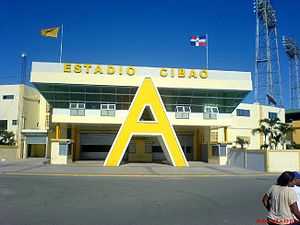
Education
Santiago is home of several universities including Pontificia Universidad Católica Madre y Maestra (PUCMM) and Universidad Tecnológica de Santiago (UTESA). Other higher learning institutions present in Santiago are: Universidad Organización & Método (O&M), Universidad Abierta para Adultos (UAPA), Universidad Nacional Evangélica and one regional campus belonging to the Universidad Autónoma de Santo Domingo
As well, Santiago has a Bi-national Center, Centro Cultural Domínico-Americano (CCDA), was founded in 1962 by a group of Dominicans and Northamericans living in Santiago. At the beginning, its Director was sent by the North American Government and it started with English classes and then the library was opened as well as the service of lending over head projectors and documentary films. These last two were lent by the American Embassy.
CCDA is located on Estrella Sadhala Avenue. this facilities of the CCDA were opened in December 1976 which was the same year of the bicentenary of the United States. Throughout its 50 years of existence, teach English, painting class an manual activities.
Transportation
Santiago has Share taxis (called Carros Públicos or conchos) and private and independent bus owners who form their own routes according to their demands
The city has private bus transportation to other cities. Bus companies include Dioni, Metro, Caribe Tours, Transporte Espinal, Aetra Bus.
The Autopista Juan Pablo Duarte highway, officially known as DR-1, passes by the city center and connects the city directly to Santo Domingo. Other minor highways connect the city to Puerto Plata, Samana, and the northwestern region of the country.
The Cibao International Airport serves mostly Dominicans living in the United States and other Caribbean islands like Cuba, Turks and Caicos Islands, Puerto Rico and Panama.[17] The former airport of the city was the Santiago Municipal Airport, a regional airport that closed in March 2002. It served destinations such as San Juan, Port-au-Prince, Miami and Santo Domingo with regular services.
Health
Facilities include Cabral y Baez, Clínica Corominas, and Union Médica, and Hospital Metropolitano De Santiago which offer their services in the city.
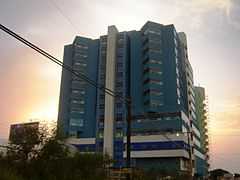
New projects
- Gran Cibao Hotel – 11 stories high, it is the largest hotel in the Cibao region.
- Light Rail in Santiago – A Light Rail development in the city's metro area has been proposed. If completed it will be the second city In the nation to have a mass transit system and would be 3.4 miles (5.5 km) longer than the Metro of Santo Domingo. The Light Rail will have 12 stops, its route will be from the Cemetery to the Airport. Construction was scheduled to begin in October 2007 but currently the project has been delayed and on Hold.
- Electric "Highway" from Santo Domingo – Santiago's power comes from Puerto Plata, but the government commenced the building of the Electric "Highway" that will feed Santiago electric energy from Santo Domingo's generators. construction started in February 2007.
The industrialists of Santiago have defended the project since it is considered to be a solution to the lack of green spaces suitable for relaxation in the city. Nevertheless it has been argued that the granting of contracts for the different phases from this project violate the frame of transparency and legality. In the Strategic Plan of Santiago it is indicated that the construction of the Metropolitan Park would increase the Santiagos green area from its currently 1.1% to 4%.
- Santiago Inteligente and Santiago Massive Training Program (SMART)-An initiative launched by Eddy Martinez Manzueta during his tenure at the Center for Exports and Investment of the Dominican Republic (CEI-RD, 2004-2012), and the Plan Estrategico de Santiago seeking to foster the new regional economic development and branding strategy and the promotion of Santiago as a knowledge-based production center in both conventional and emerging sectors, including Health Tourism, ITES-BPO, biotechnology and agro-business, as well as High-value manufacturing and Fashion (textiles and apparel, footwear), among others.
Recreation
Some of the recreational places found in Santiago are:
- Centro Español: located in the Panamericana Avenue, this place is heavily frequented during the summer by Santiago's local population and tourists. Many activities take place in it, such as sports; swimming, basketball, baseball, softball, football, golf, table games, and children summer camps. They also host parties with famous Dominican and international artists. Its access is restricted to registered members only.
- Gurabito Country Club: Another popular club located in Panamericana Avenue, it is another recreational center. They have sports activities, such as baseball and basketball. Parties with Dominican artist take place periodically in this club as well as some pool parties with Dominicans singers. Access is restricted to members only.
- Kaskada Agua Park: Located in Panamericana Avenue too, is a water theme park. This locale is open to the general public.
Notable people from Santiago de los Caballeros
Actors, artists, musicians, writers
- Fernando Cabrera (writer) – Dominican poet, visual artist and song writer
- Aisha Syed Castro – violinist
- Laura García-Godoy - actress
- Eddy Herrera – Merengue singer
- Krisspy – Merengue singer
- Clara Ledesma - painter
- Ñico Lora – Merengue musician
- La Materialista - rapper and actress
- Manny Pérez – actor
- Frank Perozo - actor
- Mu-Kien Adriana Sang - historian, essayist, analyst, politologist and academic
- Luis Vargas – Bachata singer
- Julio Vega Batlle - author and diplomat
Athletes
- Luis Felipe Lopez (Basketball) - 1st Dominican born player Drafted in the 1st round of the 1998 NBA Draft Ens. Libertad c/3#193
- José Cabrera – MLB player for the Houston Astros, Atlanta Braves and the Milwaukee Brewers
- José Lima – baseball player
- Julián Tavárez – baseball player
- Ángel Berroa – baseball player
- Luis Polonia – baseball player
- Tony Peña Jr. – baseball player
- Jose Reyes – baseball player for the Toronto Blue Jays
- Jhonny Peralta – baseball
- Joaquín Benoit – baseball player
- Rafael Belliard-baseball player and cousin of Washington Nationals 2B Ronnie Belliard
- Carlos Almanzar – baseball player
- Carlos Villanueva – MLB player for the Toronto Blue Jays
- Bill Castro–MLB player for the Milwaukee Brewers, New York Yankees, and the Kansas City Royals; pitching coach of the Milwaukee Brewers
- Carlos Gómez – baseball player for the Milwaukee Brewers
- Leonardo Cruz – boxer
- Bernie Castro – baseball player
- Winston Llenas – former baseball player
- Luis Pujols – former baseball player
- Al Alburquerque – baseball player
- Víctor Díaz – baseball player for the Baltimore Orioles
- Franquelis Osoria – baseball player
- Alfredo Simón – baseball player for the Baltimore Orioles
- Francisco Peña – Dominican baseball player for the New York Mets Son of Tony Peña and brother of Tony Peña, Jr.
- Ramón Peña – former baseball relief pitcher and member of the famous baseball Pena family*
- Leo Garcia – former baseball player
- Robinson Checo – former baseball player
- Rudy Hernández – former baseball player
- Luis Silverio – former baseball player who is now a coach
- Carlos Triunfel – baseball for the Seattle Mariners organization
- Hipólito Pichardo – former baseball of the Kansas City Royals, Boston Red Sox and the Houston Astros
- Victor Martinez – IFBB bodybuilder, runner-up many years for Mr. Olympia
- Marcos Diplan - major league baseball pitcher
- Victor Estrella Burgos - Tennis player, first Dominican to win an ATP tournament, first Dominican on the ATP top 100
- David Ortiz - baseball player (Boston Red Sox)
- Delvin Rodriquez, Jr. - middleweight boxer
- Adriano (Nani) Marrero- light welterweight boxer
Politicians
- Joaquín Balaguer – Dominican President
- Salvador Jorge Blanco – Dominican President, lawyer and a writer
- Rafael Filiberto Bonnelly – Dominican President, lawyer, scholar and diplomat
- Ulises Francisco Espaillat - Dominican President, and author
- Rafael Estrella Ureña - Dominican President
- Antonio Guzmán Fernández – Dominican President
- Hipólito Mejía – Dominican President
Francisco Augusto Lora - Dominican Vice President, Ambassador to Washington, USA, lawyer
Other
- Miguel Cocco
- Martha Heredia – Latin American Idol
- Amelia Vega – Miss Dominican Republic 2002, Miss Universe 2003
- Mons. Agripino Núñez Collado – former rector of Pontificia Universidad Católica Madre y Maestra (1970 - 2015)
Sister cities
Santiago has twinning agreements with the following sister cities:
 Havana (Cuba)
Havana (Cuba) Santiago de Compostela (Spain)
Santiago de Compostela (Spain)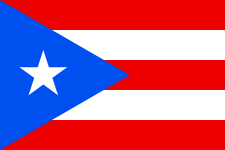 San Juan (Puerto Rico)
San Juan (Puerto Rico) Mayagüez (Puerto Rico)
Mayagüez (Puerto Rico)
Photo gallery
-
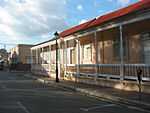
Houses in Santiago's Old Historic Center
-

Nuestra Señora de la Altagracia Catholic Church
-
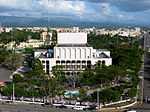
Gran Teatro Regional del Cibao
-

A view of the Northeastern section of Santiago
References
- ↑ De la Fuente, Santiago (1976). Geografía Dominicana (in Spanish). Santo Domingo, Dominican Republic: Editora Colegial Quisqueyana.
- ↑ Ayuntamiento de Santiago de los Caballeros (13 July 2011). "Datos Demográficos". Ayuntamientosantiagord.com. Retrieved 4 November 2011.
- ↑ Staff writers (22 August 2007). "Dominican Republic Central Regigon". Ministry of Tourism. Archived from the original on 22 November 2007. Retrieved 22 August 2007.
- ↑ "Santiago, Dominican Republic Climate Normals 1961-1990". National Oceanic and Atmospheric Administration. Retrieved December 24, 2012.
- ↑ ONAMET/ National Bureau of Meteorology (Recorded on September 13, 1960)
- ↑ EFEMÉRIDES METEOROLÓGICAS DOMINICANAS (Recorded on January 31, 1987)
- ↑ Ogimet.com (Recorded on March 9, 2010)
- ↑ http://one.gob.do/themes/one/dmdocuments/TMC/Santiago/Santiago.pdf
- ↑ "Iglesia Catedral Santiago Apostol El Mayor". Archivohistorico.santiagodominicana.com. Retrieved 4 November 2011.
- ↑ "Puente Hermanos Patiño". Archivohistorico.santiagodominicana.com. Retrieved 4 November 2011.
- ↑ "Monumento a los Heroes de la Restauración". Archivohistorico.santiagodominicana.com. Retrieved 4 November 2011.
- ↑ "Museo Cultural Fortaleza San Luis, Santiago, República Dominicana". Livio.com. Retrieved 4 November 2011.
- ↑
- ↑ "at". Aguilascibaenas.net. Retrieved 4 November 2011.
- ↑ "www.lainformacionrd.net". lainformacionrd.net. 30 October 2011. Retrieved 4 November 2011.
- ↑
- ↑
Venyve.com Venyve.com Santiago de los caballeros
External links
| Wikimedia Commons has media related to Santiago de los Caballeros. |
| ||||||||||
| ||||||||||||||||||||||||||||||||||||||||||||||||||||||||||||||||||||||||||||||||||||||||||||||||||||||||||||||||||||||||||||||||||||||
